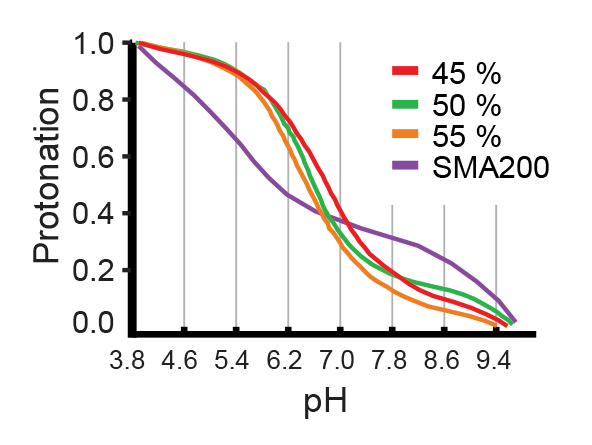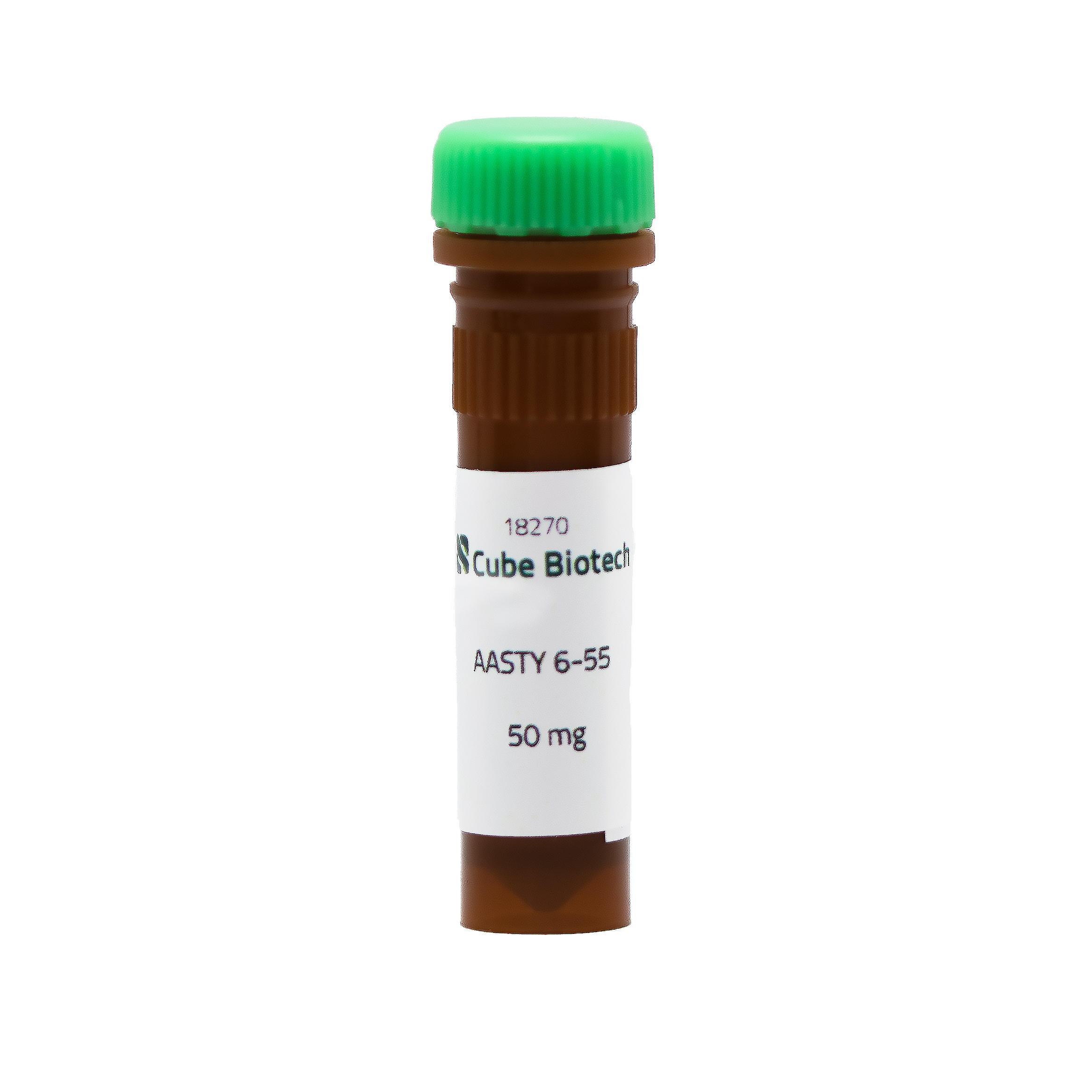AASTY 6-55
Order number: 18270
Description
AASTYs (Acrylic acid-co-styrenes) - like AASTY 6-55 - are highly-alternating copolymers, well-suited for the generation of native lipid nanodiscs. They are a 2022 novel developed series for membrane protein solubilization & stabilization. AASTY 6-55 gets its name from its molecular weight and Acrylic Acid : Styrene Ratio. These varying ratios of acrylic acid to styrene contribute to the hydrophilic properties of our AASTYs. In general lighter AASTYs, like 6-55 tend to be more aggressive, while heavier AASTYs, such as 11-45 show higher thermodynamic stability.
The exact composition of AASTY copolymers shows different extraction efficiency, depending on the lipid composition of the lipid bilayers being formulated into nanodiscs. As AASTY is made by controlled radical polymerization techniques, the dispersity of polymer molecular weight distribution is low, and the molecular weights are controlled. This means that excess AASTY copolymer can be removed by dialysis after nanodisc formation. Based on previous findings on SMA, it is the expectation that AASTY of different molecular weights will display different rates of nanodisc formation, extraction efficacy, and stability of resulting nanodiscs.
Every membrane protein solubilization needs to undergo a screening process in before. The characteristic phospholipid environment surrounding the different membrane proteins in question peforms differently well with each polymer. To support you in this process we offer a handy Screening Kit for AASTYs to test them all. Additionally, we recommend the two following publications if you would like to get further information: Smith et al. 2020 & Timcenko et al. 2022
The exact composition of AASTY copolymers shows different extraction efficiency, depending on the lipid composition of the lipid bilayers being formulated into nanodiscs. As AASTY is made by controlled radical polymerization techniques, the dispersity of polymer molecular weight distribution is low, and the molecular weights are controlled. This means that excess AASTY copolymer can be removed by dialysis after nanodisc formation. Based on previous findings on SMA, it is the expectation that AASTY of different molecular weights will display different rates of nanodisc formation, extraction efficacy, and stability of resulting nanodiscs.
Every membrane protein solubilization needs to undergo a screening process in before. The characteristic phospholipid environment surrounding the different membrane proteins in question peforms differently well with each polymer. To support you in this process we offer a handy Screening Kit for AASTYs to test them all. Additionally, we recommend the two following publications if you would like to get further information: Smith et al. 2020 & Timcenko et al. 2022
| Feature | |
|---|---|
| State | Lyophilized Powder, to be solved with water |
| Molecular Weight | 5-6 kDa |
| Buffer | HEPES |
| pH after solving | 7.5 |
| Divalent cationic tolerance | 6 mM |
| Acrylic Acid to Styrene Ratio | 55% to 45% |
| Shipping Temperature | ambient temperature |
| Storage of lyophilized copolymer | -20°C for several years |
| Storage of dissolved copolymer | 2-8°C for several days |
Lab Results
As every membrane protein, surrounded by its characteristic phospholipid environment, performs differently well with every other polymer, it is generally advisable to screen for the most viable conditions of your protein of interest. However, when you're interested in conditions with lower polymer concentrations, AASTYs are a good choice to start with your experiments.

Video
Watch our video on how nanodisc can help you to overcome one of the most difficult challenges in protein sciences.
FAQ
Is AASTY from Cube Biotech ready to use?
Yes, AASTY is ready to use. You can start directly with solubilization. Read our protocol for more information.
Which pH is suitable for AASTY?
A pH from 7 and up is possible. AASTY does not solubilize if the pH is less than 6.5. As the different AASTY offered differ in composition, they will likely have different optimum pH, dependent on the composition of lipids being solubilized into nanodiscs.
The degree of protonation, and thus the hydrophilic/hydrophobic balance of the copolymer differs across ranges of pH. The effectivity of AASTY for a given protein can be optimized in terms of pH and copolymer used.
The degree of protonation, and thus the hydrophilic/hydrophobic balance of the copolymer differs across ranges of pH. The effectivity of AASTY for a given protein can be optimized in terms of pH and copolymer used.

Which concentrations of AASTY should I use for my protein?
You should screen the polymer to membrane protein ratio as this is system-dependent.
I used AASTY for protein solubilization and a white precipitate appeared - what happened?
AASTY likely precipitated. You should check the pH and ensure that it never drops below 7.0.
How do I quantify the amount of protein after AASTY treatment?
AASTY absorbs light at 280 nm similar to proteins due to the styrene moieties. Therefore, UV absorption is no option here. Components in Bicinchoninic Acid (BCA) assays are likely influenced by AASTY. However, the Bradford assay and SDS-PAGE work.



